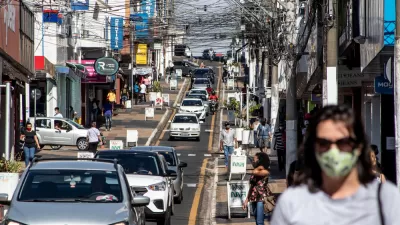The Atlantic Monthly reviews a new book on architect Oscar Niemeyer and his work that- like the infamous city of Brasilia- "continues to enchant and appall students of architecture and urban planning."
It was a heroic and inhuman scheme. From 1956 to 1960, Brazil-in an effort to cleanse itself of its colonial past, to flee its burgeoning social afflictions, and to fulfill its long-prophesied emergence as a great power-conjured a new capital, Brasília, on an empty plateau in an endless savanna 3,500 feet above sea level. The city's planner, the architect Lúcio Costa, found the setting "excessively vast out of scale, like an ocean, with immense clouds moving over it." No invented city could accommodate itself to this wilderness. Instead, Costa declared, Brasília would create its own landscape: he devised a city on a scale as daunting as the setting itself. In conformity not with its environment but with those modernist utopian theories of the rational, sterile "Radiant City," Brasília was not to grow organically but to be born, Costa said, "as if she had been fully grown"-he even refused to visit the site, because he didn't want reality to impinge on the purity of the original design. Brasília was the first place built to be approached by jet, and the city's roads- inspired by Robert Moses's deadening expressways belting New York's outer boroughs- were like runways. Here was a city without a traffic light, containing thoroughfares without crosswalks.
The result was (or should have been) obvious, as Simone de Beauvoir reported after visiting Brasília the year it was inaugurated: "What possible interest could there be in wandering about? The street, that meeting ground of passers-by, of stores and houses, of vehicles and pedestrians ... does not exist in Brasília and never will."
Today, the city is quite correctly regarded as a colossally wrong turn in urban planning-but Brasília, paradoxically, contains some of the most graceful modernist government buildings ever produced. All were designed by Oscar Niemeyer (now 100 years old and still working), who helped select Costa's master plan and who was the creative influence behind the building and shape of the city. Both facts must be considered in any effort to reckon the legacy of Niemeyer-the last great architect of the modernist ascendancy-and his relationship to modernism, a relationship that both spurred and warped his creative achievement."
FULL STORY: A Vision in Concrete

Maui's Vacation Rental Debate Turns Ugly
Verbal attacks, misinformation campaigns and fistfights plague a high-stakes debate to convert thousands of vacation rentals into long-term housing.

Planetizen Federal Action Tracker
A weekly monitor of how Trump’s orders and actions are impacting planners and planning in America.

In Urban Planning, AI Prompting Could be the New Design Thinking
Creativity has long been key to great urban design. What if we see AI as our new creative partner?

Cal Fire Chatbot Fails to Answer Basic Questions
An AI chatbot designed to provide information about wildfires can’t answer questions about evacuation orders, among other problems.

What Happens if Trump Kills Section 8?
The Trump admin aims to slash federal rental aid by nearly half and shift distribution to states. Experts warn this could spike homelessness and destabilize communities nationwide.

Sean Duffy Targets Rainbow Crosswalks in Road Safety Efforts
Despite evidence that colorful crosswalks actually improve intersection safety — and the lack of almost any crosswalks at all on the nation’s most dangerous arterial roads — U.S. Transportation Secretary Duffy is calling on states to remove them.
Urban Design for Planners 1: Software Tools
This six-course series explores essential urban design concepts using open source software and equips planners with the tools they need to participate fully in the urban design process.
Planning for Universal Design
Learn the tools for implementing Universal Design in planning regulations.
Appalachian Highlands Housing Partners
Gallatin County Department of Planning & Community Development
Heyer Gruel & Associates PA
Mpact (founded as Rail~Volution)
City of Camden Redevelopment Agency
City of Astoria
City of Portland
City of Laramie



























